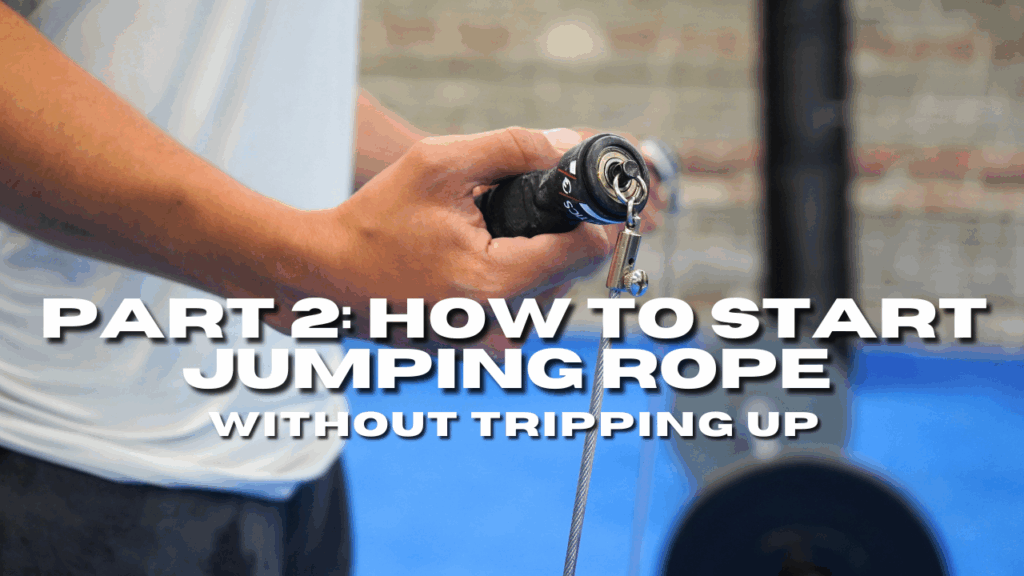
So you’ve got a rope. Maybe you’ve done a few jumps here and there, or maybe you’ve tripped over it more times than you’d like to admit.
Good. That means you’re exactly where you need to be.
Jumping rope is a skill. And like any skill—lifting, striking, skating—it’s something you develop through intent, not intensity. In Part 2 of this series, we’ll walk you through how to choose the right rope, what surfaces and shoes to use, and how to develop smooth, efficient technique so you can build coordination and endurance without frustration.
Let’s lay the groundwork.
🪢 Step 1: Choose the Right Rope for Your Goals
All ropes are not created equal. The kind of rope you use will dramatically impact your feel, timing, and control.
🔄 Speed Rope
- Light, fast, made of PVC-coated wire or cable.
- Great for fast tempo work, double-unders, or high-skill conditioning.
- Not ideal for beginners—easy to lose rhythm.
🧱 Beaded Rope
- Plastic beads strung along a cord. Audible and tactile.
- Heavier, more controlled—perfect for beginners or rhythm training.
- Excellent for learning timing and coordination.
🏋️ Weighted Rope
- Heavier handles or rope body (½ lb to 2+ lbs).
- Builds shoulder, grip, and upper-body endurance.
- Not recommended until you’ve built rhythm and control.
🎯 Recommendation:
Start with a beaded rope or light PVC rope. You want feedback—not speed—when you’re developing timing and form.
📏 Step 2: Size the Rope Correctly
The wrong rope length is one of the biggest reasons beginners struggle. Too long and it slaps the ground. Too short and it clips your feet.
✅ Proper Sizing Rule:
- Stand on the center of the rope with both feet.
- Pull the handles upward alongside your body.
- The rope should reach your armpits—maybe slightly lower if you’re more advanced.
Pro tip: Some speed ropes are adjustable. Always trim to fit your height, not someone else’s.
👟 Step 3: Set Your Foundation (Surface + Footwear)
👣 Surface Matters:
- Ideal: Rubber flooring, sprung wood, gym mats
- Okay: Grass, turf, short carpet
- Avoid: Concrete, tile, hard hardwood (too much impact risk)
👟 Footwear:
- Go for shoes with decent cushioning and support.
- Cross-trainers, minimalist trainers, or boxing shoes work well.
- Running shoes will be a bit softer and bouncier. This can help with cushioning impact and help your jump rope longer. A small downside is that it can throw off your rhythm and landings.
Optional: Once you’re skilled, barefoot or minimalist skipping can help develop foot strength and proprioception—but it’s a gradual process and requires strong tissue resilience.
🏗️ Step 4: Master the Basics — Form First
Jumping rope isn’t about how high you jump. It’s about staying efficient, rhythmic, and relaxed.
🧍 Setup & Posture:
- Stand tall with a neutral spine
- Elbows tucked in close to ribs
- Shoulders relaxed, chest up
- Eyes forward—not down
✋ Hand Position:
- Hands at about hip level
- Palms facing slightly forward
- Small wrist flicks to rotate the rope (not full arm swings)
🦶 Footwork:
- Light, elastic jumps off the balls of your feet
- Heels kiss the ground lightly, if at all
- Start with the basic bounce step (both feet jumping together)
Tip: You’re not jumping over the rope—you’re jumping just enough to let it pass under. Aim for minimal vertical lift.
🔁 Step 5: Begin with Rhythm, Not Speed
Focus on timing and feel, not reps or speed. Just like barbell work, quality comes before quantity.
Basic 5-Minute Starter Workout:
1. Basic Bounce Step — 30s on / 30s rest
Repeat for 5 rounds.
If 30 seconds is too much, use a rep target (e.g., 20 skips). Count the sound of the rope hitting the ground as part of your rhythm.
Once you’re comfortable, progress to:
- Alternate foot step (like running in place)
- Boxer step (shift weight side-to-side)
- Side-to-side jumps or single-leg hops
🧠 Common Beginner Mistakes (And How to Fix Them)
| Mistake | What’s Happening | How to Fix It |
| Jumping too high | Wastes energy and breaks rhythm | Focus on minimal lift (1–2 inches off ground) |
| Using arms to swing | Fatigue sets in quickly | Isolate the movement to the wrists |
| Rope hits feet constantly | Rope may be too short or you’re mistiming the jump | Check rope length, slow down, practice without rope |
| Looking down | Breaks posture and causes imbalance | Keep eyes forward and chest up |
| Landing heavy | Increases joint stress | Stay light, elastic, and relaxed |
🦁 Start Smart, Build Skill
Like a barbell lift, skipping rope is a technical movement that rewards practice and patience. You’ll feel awkward at first. You’ll trip. That’s normal.
But each step teaches your body and brain to move more efficiently—and that’s the foundation of athleticism.